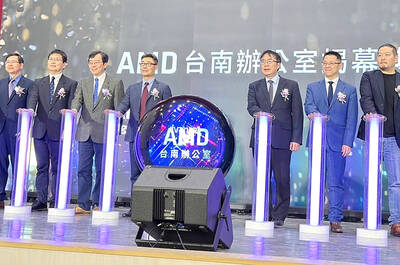The Bureau of Energy (BOE) earlier this week requested the UK’s Tongyuan Wind Power (TWP, 通威風力發電) to suspend installing six wind turbines in Miaoli County after protests by local residents who said the company’s construction activities had severely affected their quality of life.
The bureau yesterday said that more than 300 wind turbines have been installed on the west coast since 2000, but the latest incident is not the first time local residents have protested against power companies.
However, the bureau said it would make an overall review of similar projects to avoid causing public anxiety and help wind turbine installations proceed more smoothly in the future.
TWP has built 144 wind turbines in Taiwan over the past 10 years and this is the first time it has encountered protests from residents and been forced to pause construction.
On Wednesday, more than 200 Miaoli residents led by County Representative Liu Bao-ling (劉寶鈴) protested outside the Ministry of Economic Affairs to demand that the bureau end TWP’s wind turbine installations amid concerns the project would damage the county’s landscape, make low-frequency noise and affect drivers’ safety.
“TWP needs to continue further negotiations with residents on its wind turbine installation project. Before the two parties reach a deal, any kind of construction activity is banned, even though the company has obtained construction consent from the bureau,” bureau technician Chen Jing-shen (陳景生) said by telephone.
TWP said that before the construction project started in October last year, the company had reached an agreement with residents of Fangli (房裡), Haian (海岸), Shihpin (西平) and Yuangang (苑港) villages in meetings that were required by the Environmental Protection Administration during an environmental assessment.
“We invited local residents to come to meetings many times by posting announcements on the Yuanli (苑裡鎮) town hall’s bulletin board. However, only 10 to 20 people attended each meeting and the majority showed support for our construction project,” TWP deputy chief executive officer Wang Shuei-yi (王雪怡) said by telephone.
Wang said TWP in June obtained construction licenses for two and four wind turbines in the first and the second phases respectively, but was forced to stop working on the project last month, after local residents protested at the construction sites, saying that the construction had greatly reduced their quality of life.
“We provided evidence that proved our construction process was in accordance with the rules, and invited residents to visit our construction sites, but they were unwilling to accept our accounts for unknown reasons,” she said.
In response to the protesters’ claim that the six wind turbines were installed less than 200m from residents’ houses and that more than 4,000 people, or 56 percent of the township’s population, had said they did not support TWP’s construction project “because it is too close to their houses,” Wang said TWP clearly specified that each turbine was at least 350m from any building, and cast doubt on the petitioners’ reasoning and the figure of 4,000 people.
The company said it will continue talks with residents to avoid wasting equipment and money.

Anna Bhobho, a 31-year-old housewife from rural Zimbabwe, was once a silent observer in her home, excluded from financial and family decisionmaking in the deeply patriarchal society. Today, she is a driver of change in her village, thanks to an electric tricycle she owns. In many parts of rural sub-Saharan Africa, women have long been excluded from mainstream economic activities such as operating public transportation. However, three-wheelers powered by green energy are reversing that trend, offering financial opportunities and a newfound sense of importance. “My husband now looks up to me to take care of a large chunk of expenses,

SECTOR LEADER: TSMC can increase capacity by as much as 20 percent or more in the advanced node part of the foundry market by 2030, an analyst said Taiwan Semiconductor Manufacturing Co (TSMC, 台積電) is expected to lead its peers in the advanced 2-nanometer process technology, despite competition from Samsung Electronics Co and Intel Corp, TrendForce Corp analyst Joanne Chiao (喬安) said. TSMC’s sophisticated products and its large production scale are expected to allow the company to continue dominating the global 2-nanometer process market this year, Chiao said. The world’s largest contract chipmaker is scheduled to begin mass production of chips made on the 2-nanometer process in its Hsinchu fab in the second half of this year. It would also hold a ceremony on Monday next week to

TECH CLUSTER: The US company’s new office is in the Shalun Smart Green Energy Science City, a new AI industry base and cybersecurity hub in southern Taiwan US chip designer Advanced Micro Devices Inc (AMD) yesterday launched an office in Tainan’s Gueiren District (歸仁), marking a significant milestone in the development of southern Taiwan’s artificial intelligence (AI) industry, the Tainan City Government said in a statement. AMD Taiwan general manager Vincent Chern (陳民皓) presided over the opening ceremony for the company’s new office at the Shalun Smart Green Energy Science City (沙崙智慧綠能科學城), a new AI industry base and cybersecurity hub in southern Taiwan. Facilities in the new office include an information processing center, and a research and development (R&D) center, the Tainan Economic Development Bureau said. The Ministry

ADVERSARIES: The new list includes 11 entities in China and one in Taiwan, which is a local branch of Chinese cloud computing firm Inspur Group The US added dozens of entities to a trade blacklist on Tuesday, the US Department of Commerce said, in part to disrupt Beijing’s artificial intelligence (AI) and advanced computing capabilities. The action affects 80 entities from countries including China, the United Arab Emirates and Iran, with the commerce department citing their “activities contrary to US national security and foreign policy.” Those added to the “entity list” are restricted from obtaining US items and technologies without government authorization. “We will not allow adversaries to exploit American technology to bolster their own militaries and threaten American lives,” US Secretary of Commerce Howard Lutnick said. The entities